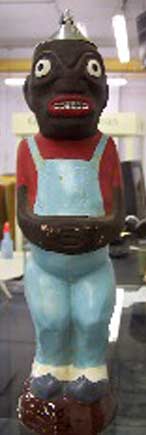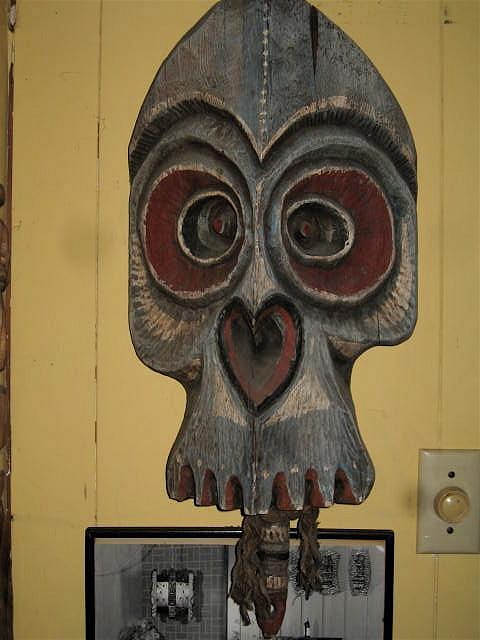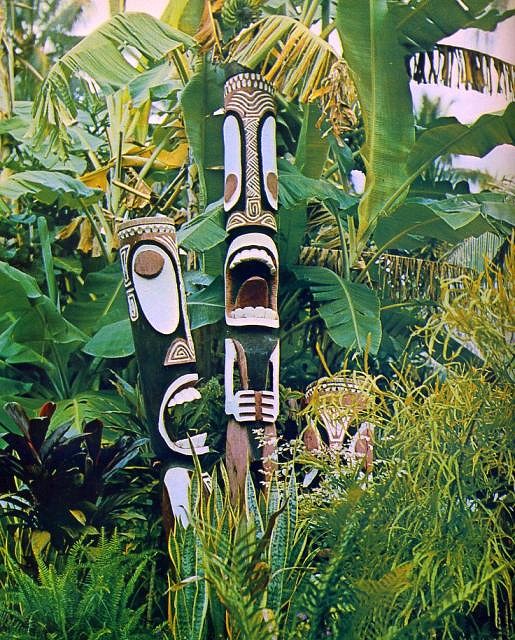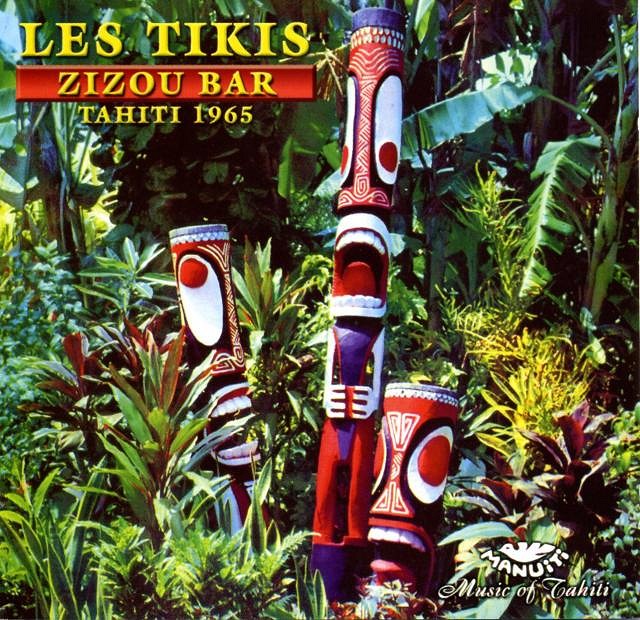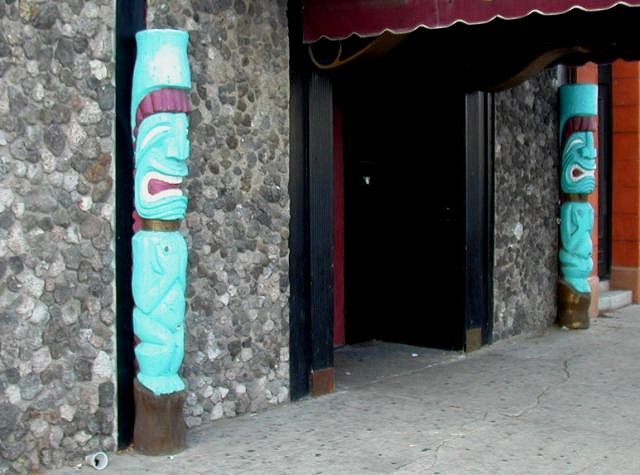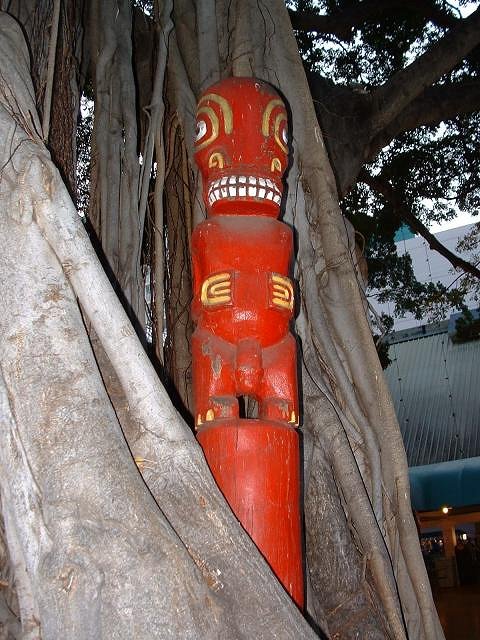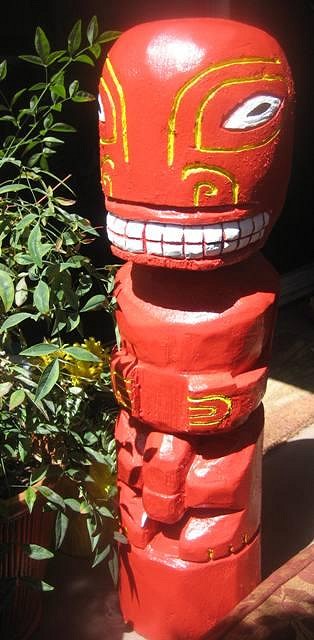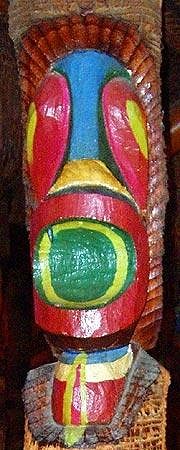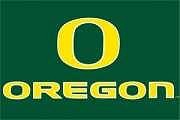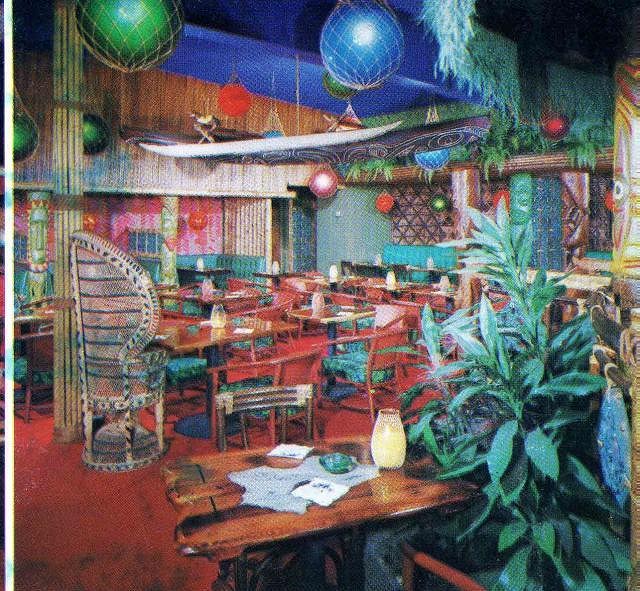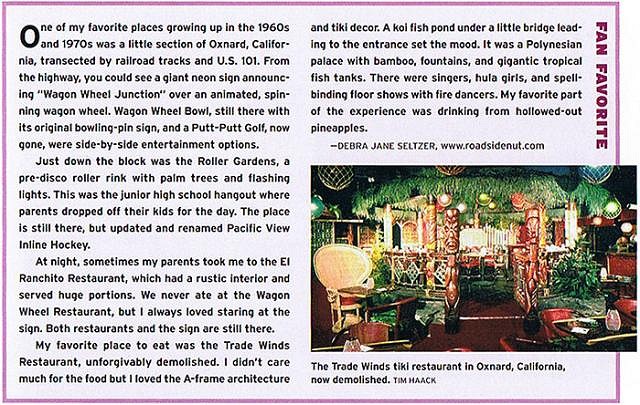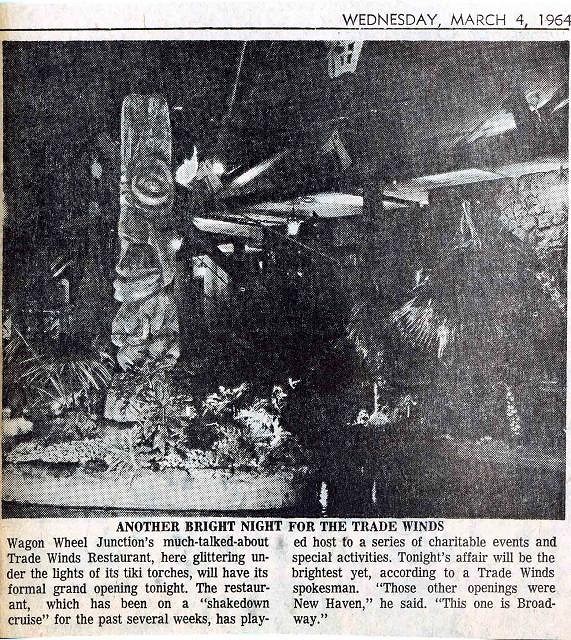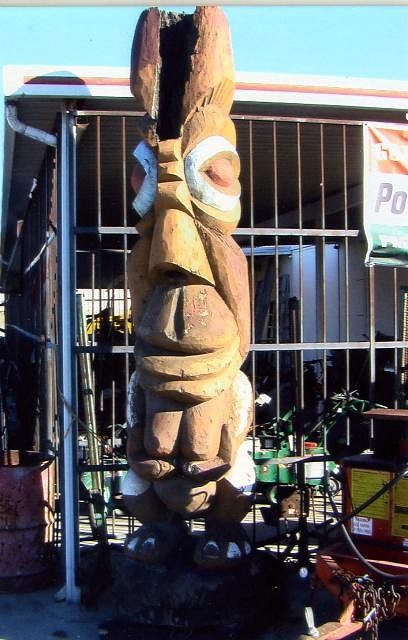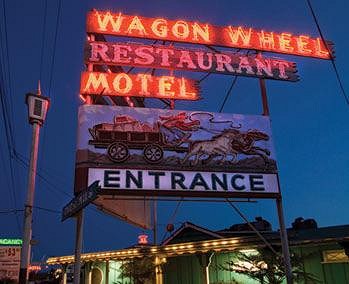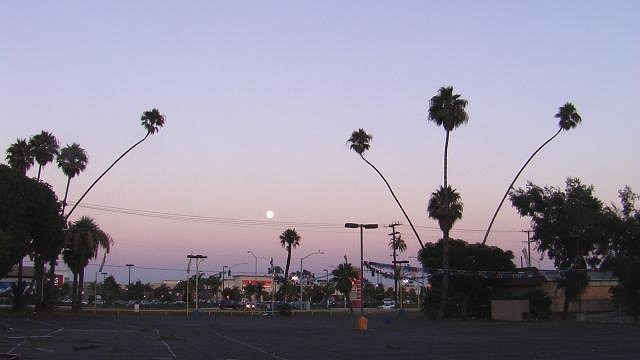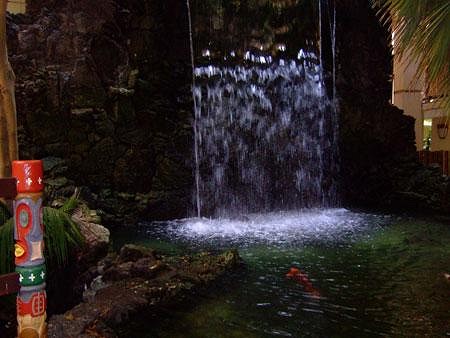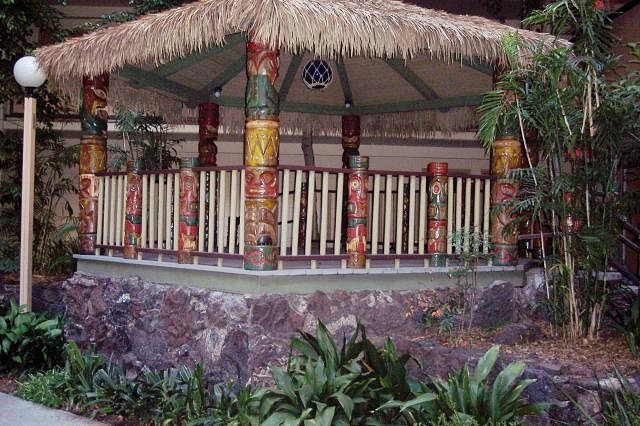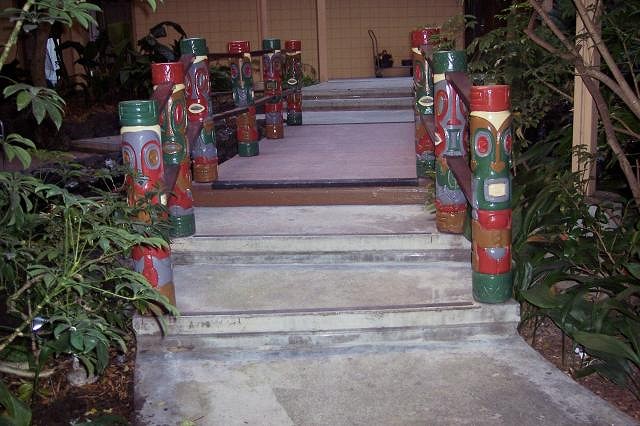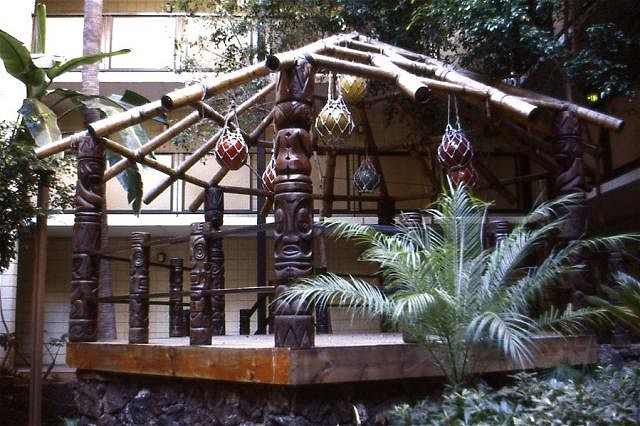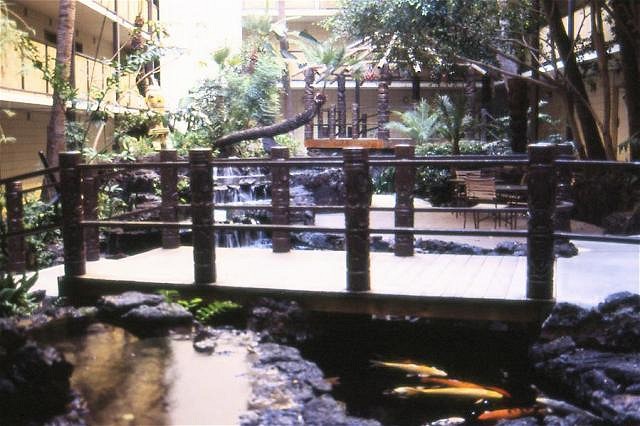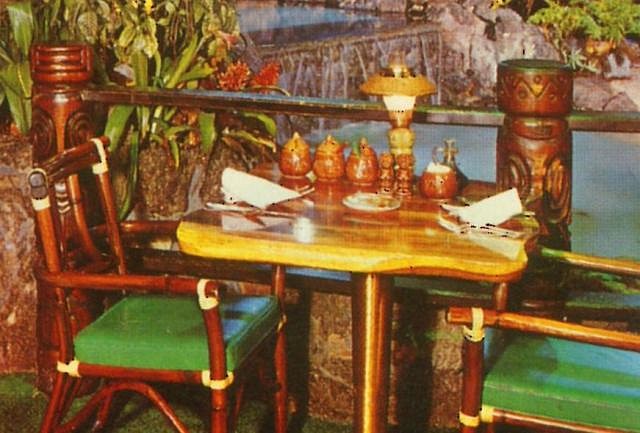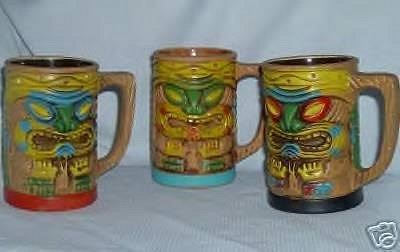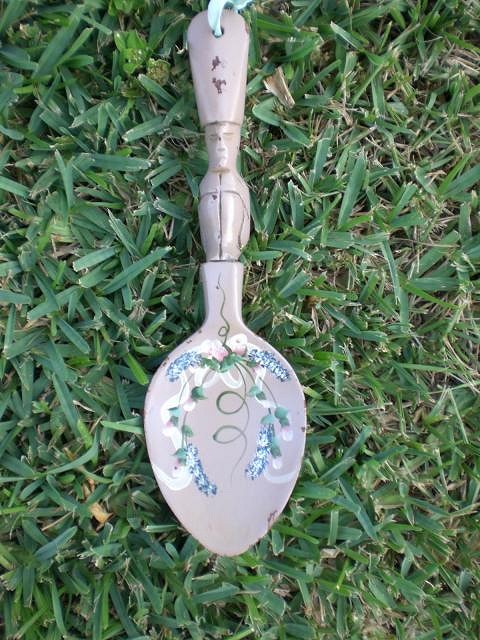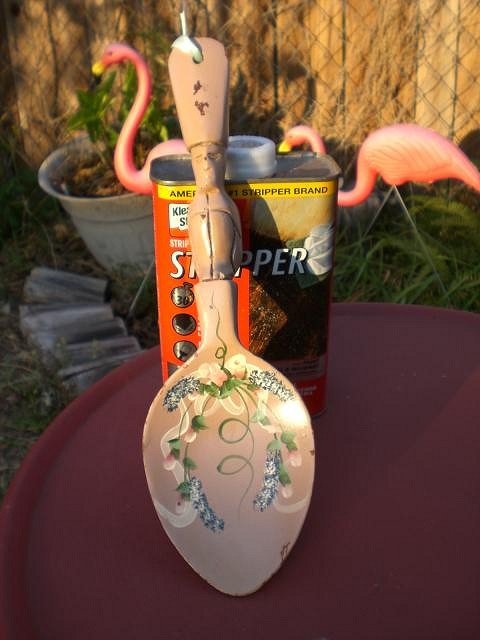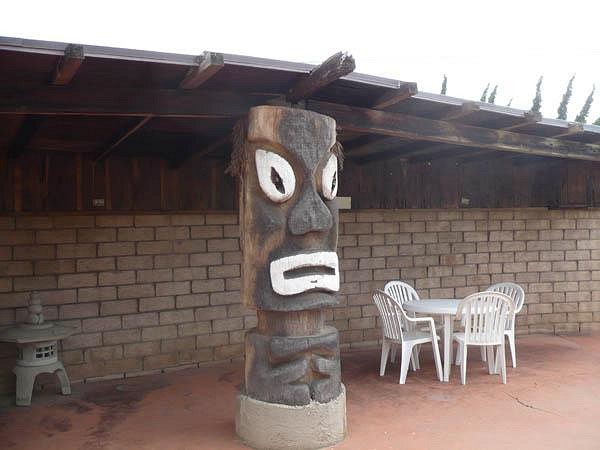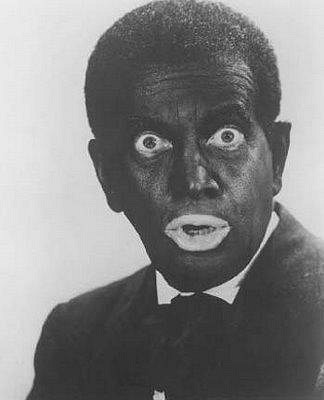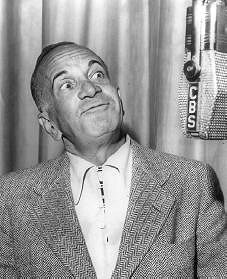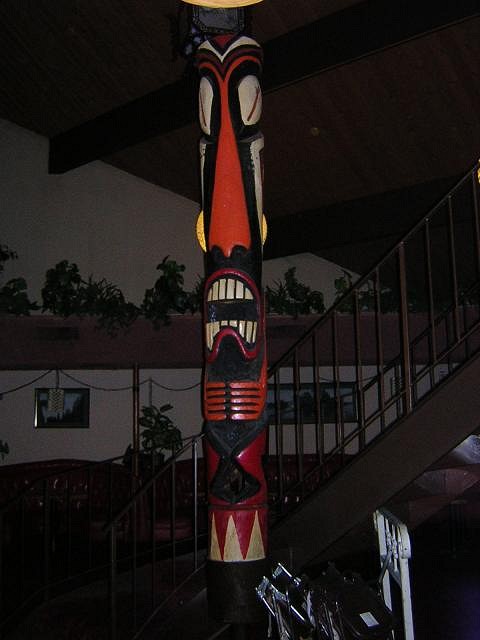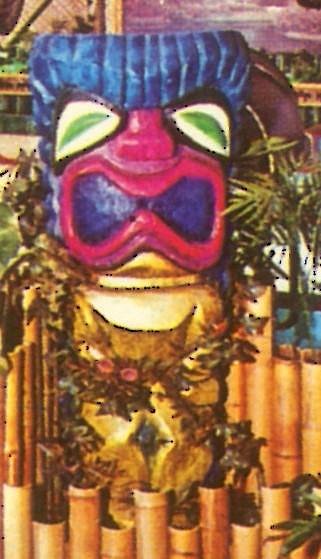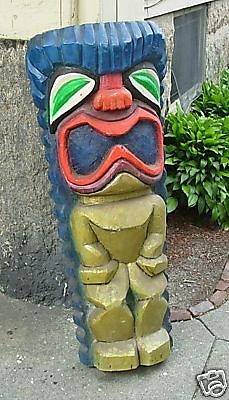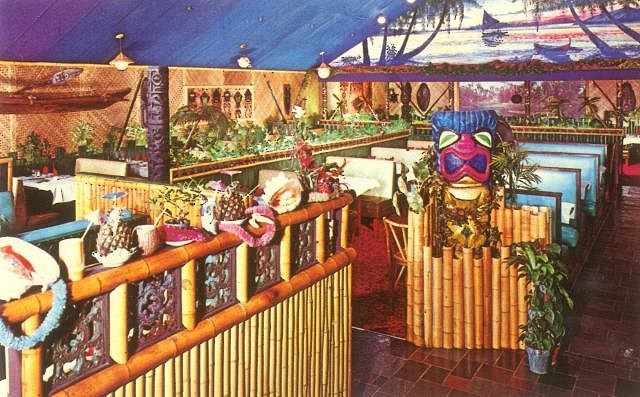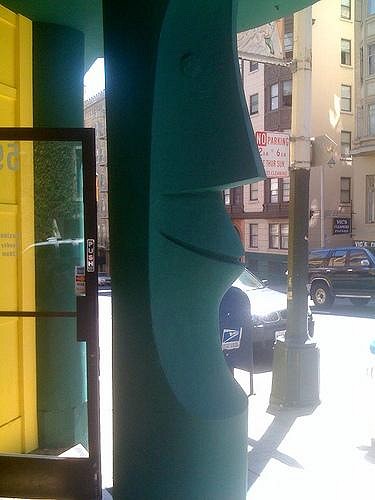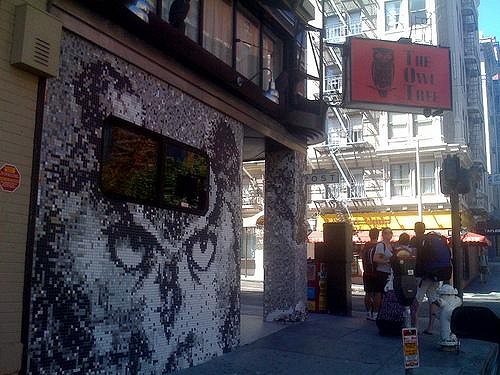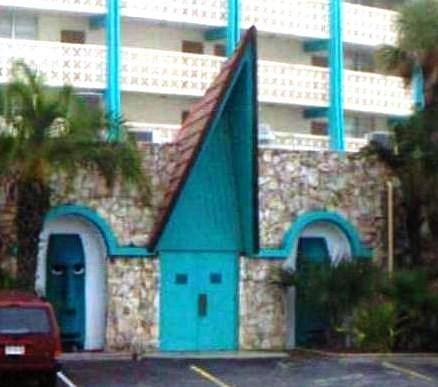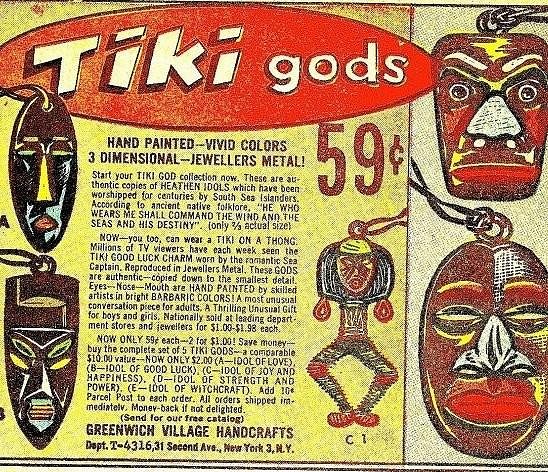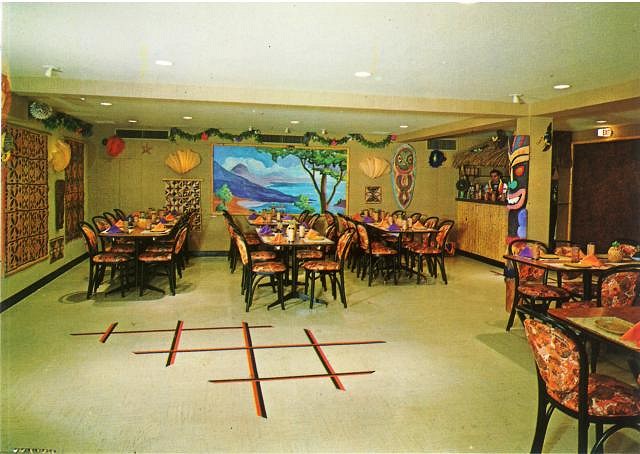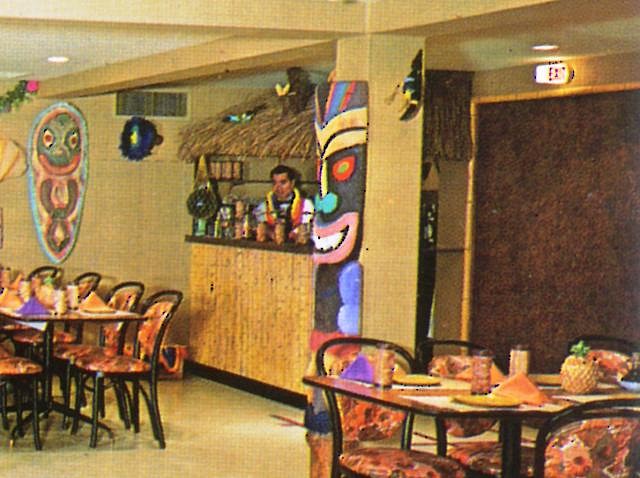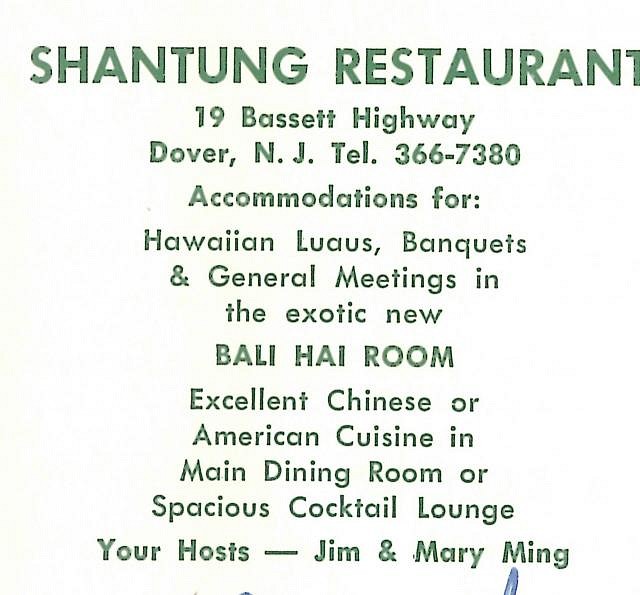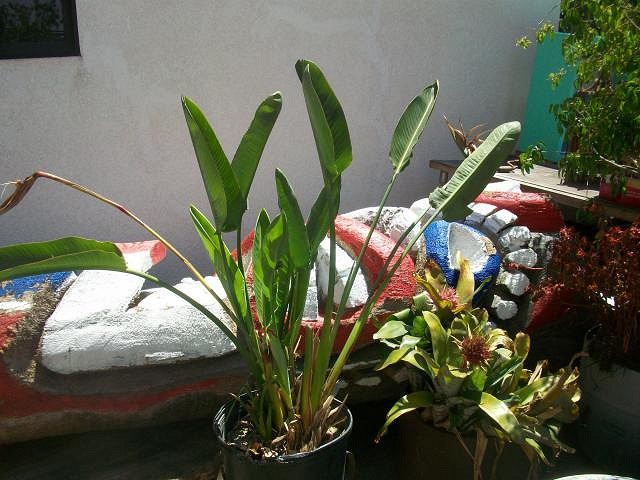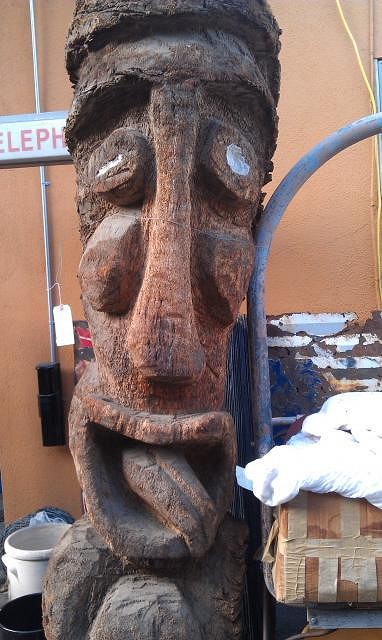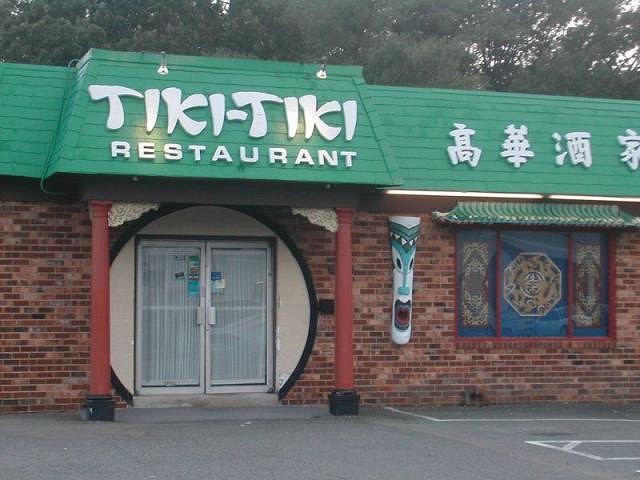Tiki Central / General Tiki
The Gallery of Regrettable Tiki Paint Jobs
|
S
SilverLine
Posted
posted
on
Tue, Apr 22, 2008 8:19 PM
I figured since it wasn't garishly painted, rather misunderstood or maybe even disguised, it wasn't a good fit. It made me laugh when I saw it. Nobody else had a clue what it really was. BTW, it's a 12-inch tall porcelain cigarette lighter that somebody painted a shirt and overalls onto. Here's he is again:
|
|
B
bigbrotiki
Posted
posted
on
Tue, Apr 22, 2008 9:28 PM
Well I think the above guy qualifies for a side genre of the "mistaken Tiki paint jobs", similar to the Tiki Bob and the Kona Kai Tiki in my very first post that began this thread. Maybe it is time to carefully introduce the subject of WHAT kind of paint job might actually be permissible on Tikis, or better, on Oceanic Art reproductions: Example Nr. 1:
Taking cues from Papua New Guinea art, the paints were washed out earth pigment type of choices that were rubbed off again, AND enriched with dirt and dust -in essence expert "primitive art" forging. This piece's color scheme looks much more authentic than O.A.'s later "Night of The Tiki" phase. This is how this carving came off the shelf, it has been hanging INSIDE since I purchased it (most of the time). Example Nr.2: A.) B.) This fine looking Tiki trio actually stood/ is standing in Tahiti. Now I could not discern if the B.) look was actual paint, applied several coats later, or if it was a similar period photo than A.) that just had the hell colorized out of it in a photo shop program. In any case, In my opinion A.) probably would look acceptable once the initial paint job had become weathered, while B.) would never look good under any circumstances. This said, this style of Tiki should really not be painted at all. [ Edited by: bigbrotiki 2008-04-22 21:46 ] |
|
V

virani
Posted
posted
on
Tue, Apr 22, 2008 10:59 PM
Sorry. I didn't read well. Now, I was about to post about the tahitian trio, that I really like, even if yes, at some point, the paint was too bright. |
|
Z

ZuluMagoo
Posted
posted
on
Thu, Apr 24, 2008 3:44 PM
Here is my submission taken down in Pueblo, CO just last week. What a lovely shade of sky blue......??????
|
|
JT
Jungle Trader
Posted
posted
on
Thu, Apr 24, 2008 4:36 PM
Those are nice carvings Zulu. :cry: I wonder if the proprietors would sell them as is. |
|
MN
Mr. NoNaMe
Posted
posted
on
Thu, Apr 24, 2008 6:37 PM
Hey now, |
|
B
bigbrotiki
Posted
posted
on
Thu, Apr 24, 2008 8:24 PM
Modern, for sure. It's a nice job, even if it is based on Tiki Devolution. While painting mid-century Tikis is just plain wrong, Tiki revival works are open to individual taste. It's not MY taste, and I hope that the crimes of the past are a warning example to a new generation of artisans, but ultimately it is out of my hands. :) |
|
T
tikijackalope
Posted
posted
on
Thu, Apr 24, 2008 11:54 PM
Does anyone else think this one at Sam's Seafood (August 2005) is supposed to be wearing a tie? |
|
B
bigbrotiki
Posted
posted
on
Fri, Apr 25, 2008 7:18 AM
Yiiiiikes! I can't say, I can't bring myself to look at this abomination long enough to decide, I have to avert my eyes. |
|
JT
Jungle Trader
Posted
posted
on
Fri, Apr 25, 2008 7:39 AM
OH THE HORROR! |
|
O
Ojaitimo
Posted
posted
on
Fri, Apr 25, 2008 10:40 AM
I just finished going through all 4 pages. Almost made me physically ill. I kid you not! |
|
TGT

The Granite Tiki
Posted
posted
on
Fri, Apr 25, 2008 10:52 AM
"Does anyone else think this one at Sam's Seafood (August 2005) is supposed to be wearing a tie? " Maybe they initiated a dress code that year. :) |
|
M
ManFromT.I.K.I.
Posted
posted
on
Fri, Apr 25, 2008 11:51 AM
The mouth . . . coincidence? I don't think so! No way that painter/defacer wasn't a Ducks fan. We may have the first documented case of the rare sportsTiki variant. |
|
O
Ojaitimo
Posted
posted
on
Fri, Apr 25, 2008 1:09 PM
The Tiki Temple room at the Trade Wind's in 1964. The painted Tiki must have made Richard Ellis cringe when he saw them finished, at least I hope they did. I'm not sure who made that command decision to paint them or they came that way. Maybe Leroy and Bob can tell us.
|
|
B
bigbrotiki
Posted
posted
on
Fri, Apr 25, 2008 1:28 PM
Tim, I just drove by the Wagon Wheel junction last weekend, what a sad sight. What year did they shut down the Motel and restaurant? |
|
O
Ojaitimo
Posted
posted
on
Fri, Apr 25, 2008 7:01 PM
Yes, sad. The Wagon Wheel Restaurant was closed in 2005, and the motel was closed in November 2006. The Wagon Wheel Bowl is still open but the rest is sitting vacant. San Buena Ventura Conservancy has the Wagon Wheel designated as a landmark so maybe there is some hope. The trees on the Trade Wind;s former site would be the perfect place for a new Don the Beachcomber.
Wagon Wheel, Oxnard, California The Wagon Wheel's neon sign visible from Highway 101. [ Edited by: Ojaitimo 2008-05-14 14:48 ] |
|
DNH
Daves Not Home
Posted
posted
on
Tue, May 6, 2008 4:02 PM
Spotted in the Hanalei Hotel/San Diego last year |
|
D
Dustycajun
Posted
posted
on
Tue, May 6, 2008 5:51 PM
I have to believe that the original Tikis at the Hanalei Hotel were not painted like they are today. Here are some more shots of the carnage from my last trip there. Does anybody have pics of when these were not painted.
|
|
B
bigbrotiki
Posted
posted
on
Tue, May 6, 2008 10:21 PM
Yeah, they probably keep on re-coating them that way too. That's what I call adding (visual) insult to injury (the tearing out of the restaurant). Here are the classic post carvings, which all came from the even more classic Beverly Hills Luau (whose name will be insulted soon, too), in their original state:
|
|
D
Dustycajun
Posted
posted
on
Tue, May 6, 2008 10:47 PM
Bigbro, I totally forgot that those tiki posts at the Hanalei had been moved over from the Luau. Thanks for the pictures. That makes the paint job seem much worse. Here is a close up from their original home in the Luau dining room. What fools!!
|
|
K
Koolau
Posted
posted
on
Sun, May 11, 2008 1:11 AM
Regrettable vintage mugs - right now on eBay:
|
|
TT
Tiki Trav
Posted
posted
on
Sun, May 11, 2008 4:59 PM
OH NO!!! What next? The hanalei is slowly being destroyed! |
|
SF

Slacks Ferret
Posted
posted
on
Mon, May 12, 2008 8:41 AM
I may have walked into the Hanalei just after the painting travesty was done... |
|
SF

Slacks Ferret
Posted
posted
on
Mon, May 12, 2008 8:45 AM
Oh, never mind...that was just a "freshnin' up the travesty" coat. |
|
O
Ojaitimo
Posted
posted
on
Wed, May 14, 2008 2:38 PM
Have any of you seen that new bio degradeable paint stripper they advertise on TV that is non toxic? Does this stuff work quickly during a night |
|
M
Moai_Mama
Posted
posted
on
Wed, May 14, 2008 4:27 PM
OMG @ how this little spoon dude must feel, all pink in floral tole! I simply couldn't leave him at the Salvation Army like that, for all the world to see, without removing that gawdawful goop... |
|
BB
Bora Boris
Posted
posted
on
Tue, May 20, 2008 8:20 PM
Even white paint can ruin a guy if it’s in the wrong places.
Like this Tiki from The Isle apartments in El Segundo. |
|
TG
The Gnomon
Posted
posted
on
Wed, May 21, 2008 11:42 AM
Looks like a Tiki Al Jolson Probably his most well known persona from The Jazz Singer...
What he looked like without makeup...
I guess the act was really popular at the time. I don't think our brothas and sistas approved. Today Rev Sharpton could probably get anyone doing blackface act like that deported to Antarctica. [ Edited by: The Gnomon 2008-05-21 11:46 ] |
|
T
Tiki-Kate
Posted
posted
on
Wed, May 21, 2008 6:40 PM
I've got to add this one from the Scorpion Sports Bar in San Bernardino.
Here's a little history on the place. Trader Island |
|
PTD
Psycho Tiki D
Posted
posted
on
Wed, May 21, 2008 6:51 PM
Al Jolson is as much a regretable tiki as is Marcel Marceau?
WTF?? PTD |
|
R
Ratzaroony
Posted
posted
on
Tue, Jul 29, 2008 6:46 AM
Is this that same tiki?
It's currently up on eBay. Not my auction, but I saw it and remembered this thread. http://cgi.ebay.com/ws/eBayISAPI.dll?ViewItem&item=330255460686 |
|
T
TikiMango
Posted
posted
on
Tue, Jul 29, 2008 7:35 AM
Looks like a rescue project. |
|
B
bigbrotiki
Posted
posted
on
Tue, Jul 29, 2008 7:50 AM
How cool. Great Tiki memory, Ratzaroony. I wonder what age that original postcard is from...I would say late 60s?:
That is unusually early for Tiki clown-painting. While it was a mistake then as it is now, it is authentic and should be kept that way. Funny, that seller doesn't even know where it came from. |
|
R
Ratzaroony
Posted
posted
on
Tue, Jul 29, 2008 8:20 AM
Agreed. I'm going to try to win it, but if I don't, I hope the winner will not repaint it. |
|
K
Kong-Tiki
Posted
posted
on
Tue, Sep 1, 2009 7:10 PM
I had not been in SF since last year when I went by Tiki Bob today to pay my respect. I was a bit put off by the new, green color, which gives The Crepe House a more Irish Pub-look. I actually think i preferred the peach color.
On the other side of the street, The Owl Tree had reopened with a new, fancy mural.
|
|
D
Dustycajun
Posted
posted
on
Tue, Sep 1, 2009 7:19 PM
These are from the Waikiki Lounge and Supper Club at the Hawaiian Inn in Daytona Beach, Fl. Before (from Sabu's Postcard)
After (from Google)
Makes you feel kinda blue. DC [ Edited by: Dustycajun 2009-09-01 19:20 ] |
|
B
builtiki
Posted
posted
on
Tue, Sep 1, 2009 8:33 PM
wow is it true that there are gay tikis....poor 1970's the tikis were just trying to get into Studio 54, with the rest of the beautiful people...just because they had to paint themselves up to be timely doesn't make them Gay!!!! |
|
O
Okolehao
Posted
posted
on
Fri, Sep 4, 2009 4:30 PM
I'm sure this photo must be somewhere on T.C. already, but "HAND PAINTED by skilled artists in bright BARBARIC COLORS!" is great. This type of medalion's painting must have had some relationship to real Tikis being painted in BARBARIC COLORS. Considering the postage was 10 cents for Parcel Post, I guess this was way before the 1970's. Did these things inspire Tikis being painted, or did Tikis being painted inspire these things? Or were these just cheap kids jewelery and nothing else? (no insult to the cheap kids) |
|
GK
Grand Kahu
Posted
posted
on
Mon, Sep 7, 2009 12:09 PM
Tikis - and various Polynesian symbolic objects (masks, etc.) WERE often ritually painted with lime, clays, and other natural pigments. This is not to say they were in day-glo groovy colors, but the brown or weathered gray tikis we all know and love are products of just that - weathering and loss of color. It's akin to the Greek Revival and the scores of white marble buildings which were constructed in the last three centuries. By then, the real ancient Greek structures had lost all of their color (and they were a riot of color) to weathering, hence Greek Revival buildings are typically white - or white. Still, it looks odd to us, as we are used to the current state of things. If Washington D.C. were color-corrected to the original Roman and Greek color schemes, most would think the city had been turned into a huge bordello. (and no, that is not a political commentary...just an architectural one) GK |
|
B
bigbrotiki
Posted
posted
on
Mon, Sep 7, 2009 2:01 PM
True about Greek sculpture, and pre-Colombian architecture, too. But in terms of Tikis, more often in Melanesia, less in Polynesia. Anyway, as far as Tiki culture is concerned, not possible historic authenticity matters, but the IMPRESSION of what was seen as "primitive art", and the concepts it represented in the 20th Century: To the moderns: The birth of art, the creative spirit of unspoiled man, the freedom from naturalistic form... All this was represented by ancient looking, simple but elegant, scary but funny, monochromatic figurines seen in the Oceanic Art exhibitions and books of the mid-century. And this is the way 1950s and 60s artisans re-created them for the modern Tiki temples of that time. Tikis, as they were found by the explorers and missionaries, are dark and brooding, not happy and flashy, and this contrast to modernity was -for a brief time- what inspired American Tiki entrepreneurs and artists. Later, they became scared of their own gutsiness and began to update them with glossy colors, destroying the effect of aged, archaic relics. That is why paint jobs on Tikis are most regrettable, no two ways about it. :) |
|
HT
Hale Tiki
Posted
posted
on
Wed, Mar 13, 2013 9:23 AM
Bumping this for posterity. It's a damn fine thread. |
|
D
Dustycajun
Posted
posted
on
Mon, Mar 18, 2013 4:30 PM
This on falls under the category of "Most regrettable Tiki Bar Attempts"! Brought to you in the 1970's during the free fall of Tiki De-evolution, the Bali Hai Room at the Shantung Restaurant in Dover, NJ. The room decor, stunning it its own right.
Several regrettable painted Tikis.
They did use Tiki mugs at least. Description from the back of the postcard.
Where's Bamboo Ben when you need him? (in Hawaii of course) DC |
|
ATP

Atomic Tiki Punk
Posted
posted
on
Mon, Mar 18, 2013 7:44 PM
That should have been called the "Party City Tiki Room" |
|
B
bigbrotiki
Posted
posted
on
Mon, Mar 18, 2013 8:37 PM
The abstract design on the floor really saves the day! :lol: Amazing how within one generation, the knowledge and know how was lost. Those are Orchids Tikis, of course. |
|
T
tikilongbeach
Posted
posted
on
Tue, Mar 19, 2013 8:16 AM
It looks like Polynesian night at a community center or retirement home. |
|
T
tikilongbeach
Posted
posted
on
Tue, Mar 19, 2013 8:24 AM
This circus clown painted big tiki was for sale for quite a long time at Warehouse 1333 in Long Beach. It still could be, I haven't be in there in over a year.
This tiki only had his eyes painted white so he got off pretty easy. He's still for sale at the Long Beach Antique Mall II.
The original thread: -Lori [ Edited by: tikilongbeach 2013-03-19 08:29 ] [ Edited by: tikilongbeach 2013-03-19 08:30 ] |
|
T
tikilongbeach
Posted
posted
on
Tue, Mar 19, 2013 11:28 AM
Painted tiki on the outside of Tiki-Tiki Chinese Restaurant in Richmond, VA.
http://www.tikicentral.com/viewtopic.php?topic=7528&forum=2&hilite=richmond |
|
B
bigbrotiki
Posted
posted
on
Tue, Mar 19, 2013 11:40 AM
He looks like he could have been a Mike Gildea job: http://www.tikicentral.com/viewtopic.php?topic=38445&forum=1&start=0 http://www.tikicentral.com/viewtopic.php?topic=22886&forum=2 |

